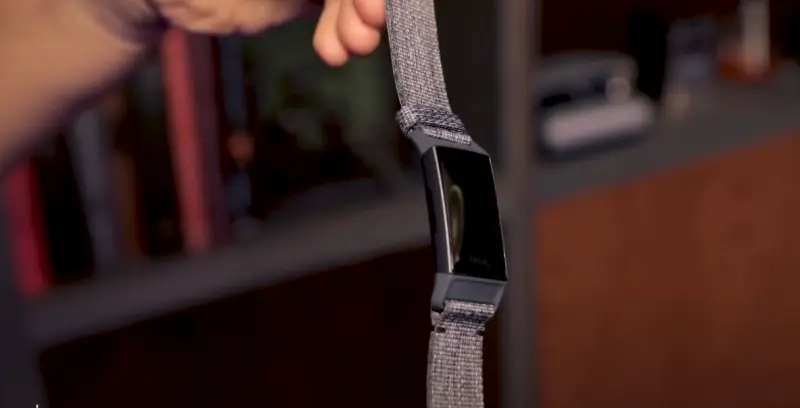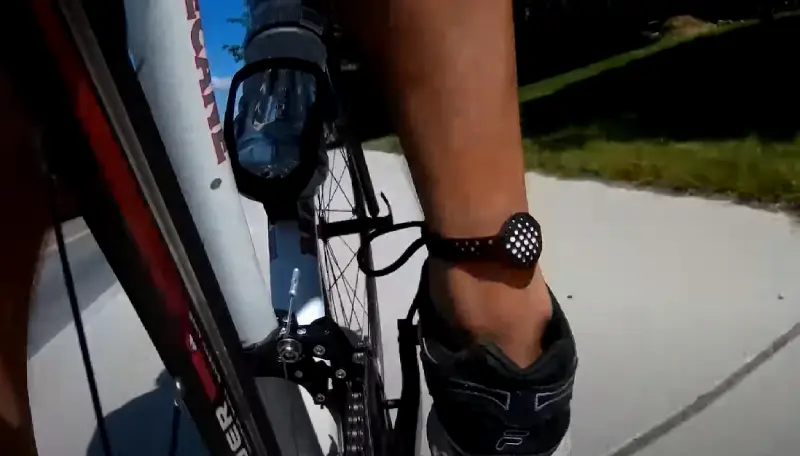Fitbits can be worn on ankles depending on your needs and the current situation. Wearing a Fitbit on your ankle can achieve a more precise step count and enhance cycle tracking.
This allows for accurate measurement of both steps and cycling activity. Fitbits count steps even when worn on the ankle. Opting to wear it on the ankle ensures more precise and reliable results for cycling.
Yes, you can wear your Fitbit at the ankle while cycling. Some users have suggested that wearing the device on the ankle provides more accurate readings for certain activities, like cycling. It is essential to remember that Fitbits are worn on the wrist.
In this blog post, we explore whether you can wear Fitbit on the ankle for cycling, along with its benefits and considerations.
Key Takeaways
- If you’re a cycling enthusiast, you may have wondered about the best way to track your rides using a Fitbit. While Fitbits are typically worn on the wrist, wearing a Fitbit on the ankle can provide more accurate measurements for cycling-specific metrics. For instance, ankle-worn Fitbits can give reliable measurements of speed, cadence, and pedal stroke angles.
- However, not all Fitbits are suitable for ankle wear during cycling. Flat, lightweight Fitbits are ideal since bulky models can cause discomfort or chafing. A water-resistant Fitbit is recommended to prevent damage from sweat and moisture.
- It’s also important to wear your Fitbit inside the ankle bone to avoid injury during cycling. Ensure that the Fitbit fits perfectly; it should be snug but not too tight or loose.
- Cycling necessitates a Fitbit with sufficient life to continue monitoring. Some Fitbit models, such as the Fitbit Surge, come with a ‘Multi-Sport Mode’ and GPS for cycling-specific tracking, as well as a companion app for cycling workout analysis.
Fitbits on your Ankles when Cycling: 7 Considerations
Note these critical factors. From ensuring a snug fit to selecting the most suitable Fitbit model, these guidelines will maximize the benefits of your ankle-worn device. Remember the significance of positioning, water resistance, precise tracking, and battery life for an optimal cycling experience.
Heart Rate Tracking
The ankle is not ideal for heart rate tracking, as it is further from the heart. The Fitbit App cannot track your heart rate if worn on your ankle.
Proper Fit and Comfort
Choose a snug yet comfortable fit if you plan to wear your Fitbit on your ankle for cycling. Fitbits should not be tight or loose but just the right fit to avoid unnecessary discomfort.
Type of Fitbit
Some Fitbits are better suited for ankle wear than others. Fitbits should be flat and lightweight before being worn on the ankle during cycling. Bulky Fitbits may cause discomfort or even chafing when worn on the ankle.
The Position
Your Fitbit should be placed on your ankle. Position your Fitbit inside your ankle bone to avoid injuring the area during cycling.
Water Resistance
Your Fitbit can be damaged by sweat and moisture; the more you bike, the more sweat you produce. To prevent moisture damage to your Fitbit, choose a water-resistant model.
Accurate Tracking
Your Fitbit may need to track your steps accurately if you wear it on your ankle while cycling. The device may not recognize cycling motions as steps, resulting in inaccurate tracking.
Battery Life
Cycling requires your Fitbit to have enough battery life to last the duration of your ride. Charge your Fitbit before you cycle.
Tips To Wear Fitbit On Ankle For Cycling
If you’re looking for a Fitbit for cycling or other activities where wrist placement might not capture all movements accurately, here’s a detailed guide on how to do it properly:
- Choose the Right Size Wristband or Ankle Strap: Ensure the wristband or ankle strap fits comfortably around your ankle. Choosing a band specifically made for the ankle or adjustable enough to fit securely without being too tight or loose is essential.
- Place the Device Inside the Ankle Strap: If you’re using a specially designed ankle strap, it will probably have a pocket or holder for the Fitbit device. Slide your Fitbit into this section ensuring it’s secure. If you’re adapting a large wristband or creating a DIY solution, make sure the device is positioned to remain stable and won’t rotate or move excessively during cycling.
- Fasten the Strap Securely Around Your Ankle: Wrap the strap around your ankle and fasten it. The fit should be snug so the device doesn’t slide down as you move, but not so tight that it restricts circulation or feels uncomfortable.
- Position the Device in the Middle of Your Ankle Bone: Position the device near the middle of your ankle for optimal tracking. This placement helps capture the movements specific to cycling better, as the sensors can pick up leg activity more effectively than when on the wrist.
- Sync the Device to Your Smartphone or Computer to Accurately Track Your Activity: Regularly sync your Fitbit with your smartphone or computer to review your activity data. While the Fitbit is designed for wrist wear, and some metrics may be less accurate when worn on the ankle (such as heart rate), syncing will still allow you to see your steps, distance covered, and potentially cycling activity depending on the model of your Fitbit.
Fitbit on An Ankle for Cycling: 5 Benefits
Explore the benefits of utilizing an ankle-based Fitbit for cycling. Experience heightened precision in measurements, enhanced tracking of steps, distance, and cycling-specific metrics, and elevate your cycling journey to new heights with an ankle-based Fitbit.
Increased Accuracy
Fitbits worn on the ankle instead of your wrist increase the accuracy of measurements. Ankle readings are more accurate than wrist readings because arm swings and gestures can affect Fitbit distance measurement.
Since cycling is a constant movement, ankle measurements provide better step counts.
Improved Cycling Steps Count
It can frustrate those who regularly cycle to count steps on their Fitbits. The Fitbit ankle band measures steps and distance more accurately, allowing cyclists to track their achievements more accurately.
Better Track Cycling Metrics
The ankle-based Fitbit and GPS or other cycling-specific tracking tools can provide more detailed measurements of speed, cadence, and even pedal stroke angles than a regular Fitbit. With a Fitbit on an ankle, you can get better heart rate readings since the sensors are closer to the heart.
Comparison with Wrist-Worn Fitbit
Fitbit wristbands are great for tracking fitness and daily activity, but ankle-based Fitbits are much better for tracking cycling-specific metrics.
Cycling with a wrist-worn Fitbit can be inconvenient and less accurate when paired with external cycling devices.
Features of Fitbit for Cyclists
Fitbit models with cycling features include “Multi-Sport Mode,” which provides for cycling modes. Fitbit Surge also has GPS, which allows cycling tracking similar to high-end GPS cycling computers.
Cycling workout analysis is included in the Fitbit companion app, which enables users to assess their performance and track their progress during cycling workouts.
Conclusion
The feasibility of using a Fitbit while cycling hinges on the Fitbit model and the type of cycling you engage in. While ankle placement may yield accurate elevation readings, it might not be suitable for high-intensity cycling with a risk of falls or accidents.
As with any physical activity, prioritizing your safety and well-being should always take precedence. Familiarize yourself with your Fitbit’s capabilities and limitations, or seek professional advice regarding device usage. Venture forth, track your progress, and maximize the benefits of your cycling routine.
FAQs
Is Wearing Fitbit On Ankle More Accurate?
A Fitbit worn on the ankle may provide more accurate step counts, distance traveled, and sleep tracking since it is better equipped to detect all movements. The wrist placement is recommended for health metrics such as heart rate and blood oxygen levels, as the device is intended for this use and may not provide accurate readings on the ankle.
Can You Wear Whoop On Ankle?
The Whoop 4.0 can be worn on the ankle, but it is not recommended. While the Whoop Strap is designed to be worn on the wrist, its accuracy may be compromised when worn on the ankle. Moreover, it might be less comfortable for the ankle, and it might fall off during physical activity. If you’re looking for an alternative placement during cycling, you may want to experiment with other placement options or consult the manufacturer’s guidelines.
How To Stop Fitbit Counting Steps When Cycling?
Step counting in Spinning should be turned off. You can also add an exercise that does not track steps but heartbeats, zones, and calories simultaneously.
Should I wear my Fitbit inside or outside my wrist?
Can You Wear Fitbit On Inside Of Wrist?
We normally recommend using the Fitbit Blaze on the outside of your wrist but I’d say that as long as it has a steady contact with your skin for the heart rate to be recorded properly, there will be no problem at all.




